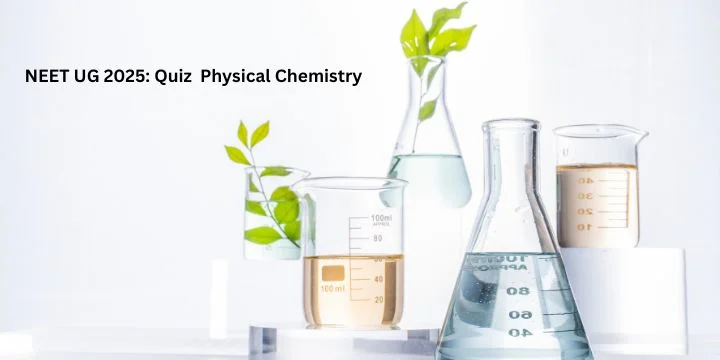New Delhi: As the NEET UG 2025 examination approaches, candidates can now engage with a specially designed quiz featuring 25 high-quality multiple-choice questions (MCQs) focused on Physical Chemistry. This subject is known for being both highly rewarding and conceptually demanding within the NEET physics-chemistry-biology framework.
This quiz is part of the daily NEET practice series and encompasses essential topics in physical chemistry, including the Mole concept, Thermodynamics, Equilibrium, Electrochemistry, Solutions, and Solid State, all aligned with the most recent NEET UG exam format.
Moreover, “Daily practice of chapter-specific MCQs is an effective strategy to maintain sharpness and readiness for the exam. These Physical Chemistry questions emphasize accuracy based on formulas. Mastery of concepts as well as their intelligent application are the three foundational elements of success in NEET,” states an expert.
One mole of any ideal gas at STP occupies:
- 22.4 L
- 24.0 L
- 1 L
- 2.24 L
The number of atoms in one mole of Na is:
- 6.022 x 10^22
- 6.022 x 10^23
- 6.022 x 10^24
- 3.011 x 10^23
The molarity of a solution containing 9.8 g of H2SO4 in one liter of solution is:
(Molar Mass of H2SO4 = 98 g/mol)
- 0.01 M
- 0.1 M
- 1 M
- 10 M
Which law asserts that energy cannot be created or destroyed?
- Hess’s Law
- Second Law of Thermodynamics
- First Law of Thermodynamics
- Zeroth Law of Thermodynamics
The work performed during a reversible isothermal expansion of an ideal gas can be expressed as follows:
- W = nRTΔ T
- W = nRT ln(V2/V1)
- W = PΔ V
- W = nCvΔ T
Also Read: NEET UG 2025 Physics Quiz Set-1: 25 Mechanics MCQs for Aspirants
In the case of an ideal gas experiencing adiabatic expansion, which of the following statements is accurate?
- q = 0
- ΔU = 0
- W = 0
- ΔH = 0
When the temperature is raised from 300 K to 310 K, the reaction rate doubles. The approximate activation energy can be calculated as follows:
(Using the Arrhenius equation, R = 8.314 J/mol-K)
- 53 kJ/mol
- 46 kJ/mol
- 69 kJ/mol
- 34 kJ/mol
The half-life of a first-order reaction is influenced by:
- Initial concentration
- Activation energy
- Temperature
- Only the rate constant
Which of the following does not qualify as a colligative property?
- Boiling point elevation
- Freezing point depression
- Osmotic pressure
- Viscosity
The van’t Hoff factor (i) for NaCl is:
- 1
- 0
- 2
- 3
Henry’s law establishes a relationship between:
- Pressure and temperature
- Solubility and pressure
- Volume and temperature
- Solubility and temperature
An ideal solution is characterized by the following conditions:
- ΔH ≠ 0
- ΔV ≠ 0
- Compliance with Raoult’s law
- Exhibiting positive deviation
In the electrochemical series, which element exhibits the greatest propensity for reduction?
- Na
- F2
- Zn
- Cu
A cell with an electrode potential of +0.76V is expected to:
- Acquire electrons
- Release electrons
- Remain neutral
- Not engage in a reaction
The standard cell potential is determined using:
- Nernst equation
- Faraday’s law
- E cell = E cathode – E anode
- Gibbs free energy equation
The unit of the rate constant for a first-order reaction is:
- Mol L⁻¹ S⁻¹
- S⁻¹
- Mol⁻¹ L S⁻¹
- L mol⁻¹ s⁻¹
Which condition maximizes buffer capacity?
- Salt >> Acid
- Acid = Salt
- Acid >> Salt
- Very dilute solutions
The pH of a 0.01 M HCl solution is:
- 2
- 1
- 3
- 4
Among the following, which has the highest boiling point?
- 0.1 M NaCl
- 0.1 M glucose
- 0.1 M MgCl2
- 0.1 M urea
Faraday’s first law of electrolysis asserts that:
- Mass ∝ Voltage
- Mass ∝ Time
- Mass ∝ Charge
- Mass ∝ Resistance
In solid-state materials, a Schottky defect occurs when:
- An equal number of cations and anions are absent
- Only cations are absent
- Only electrons are absent
- An atom is displaced from its lattice position
Chemistry Quiz: What type of solid is diamond?
- Ionic
- Covalent
- Metallic
- Molecular
Which of the following exhibits the highest conductivity in its molten state?
- NaCl
- BaCl2
- AlCl2
- CCl4
The enthalpy change associated with the reaction H2(g) + O2(I) can be classified as follows:
- Endothermic
- Zero
- Exothermic
- Indeterminate
Solution:
| 1. A | 2. B | 3. C | 4. C | 5. C | 6. B | 7. A | 8. A | 9. D | 10. D | 11. C | 12. B | 13. C |
| 14. B | 15. A | 16. C | 17. B | 18. B | 19. B | 20. C | 21. C | 22. A | 23. B | 24. B | 25. C |


Leave a Reply